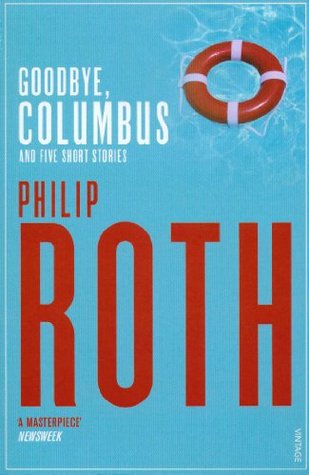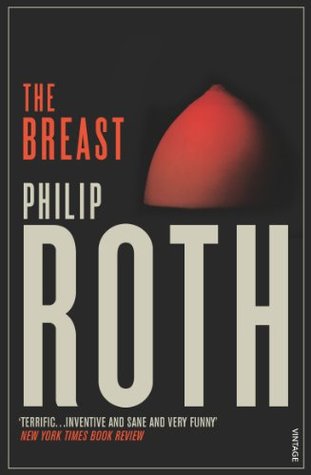Here begins my Roth odyssey. And where better to start than the beginning? So, with that obvious logic in mind, the first in an oeuvre spanning twenty-eight books (a mix of fiction and non-ficton; of standalone and series novels) is Goodbye, Columbus (1959), a novella of around one hundred pages that won the National Book Award in 1960. Bundled with it are five more short stories, each complementing the greater work in theme and style. One may assume by its length that this was Roth stepping up, stretching those muscles in search of a novel.
In reading around the book it’s interesting to note that it caused controversy in its day for the unflattering portrayal of some Jewish characters. But with Roth himself coming from a Jewish background, and the stories showing hints of autobiography, it would seem he was at least in a position to be critical about the Jewish lifestyle. Of particular delight, is that in almost fifty years it has lost none of its bite.
In Goodbye, Columbus there’s a young Negro who comes regularly to the library where Neil Klugman works and sits each time with a book of Paul Gaugin’s exotic paintings, dreaming of Tahiti (“That ain’t no place you could go, is it?”). It’s a fitting metaphor for the novella’s main focus, the summer relationship between Neil, a poor boy from Newark, and Brenda Patimkin, a spoiled girl whose father, having laboured at his business, has moved the family on up from Newark to an affluent suburb.
Neil gets invited to the local country club twice: first by his cousin, where he meets Brenda; then by Brenda herself, after asking her out. Despite their social differences, they come together – Brenda doesn’t ask many questions – and find their fondness for each other growing:
We came back to the chairs now and then and sang hesitant, clever, nervous, gentle dithyrambs about how we were beginning to feel towards one another. Actually we did not have the feelings we said we had until we spoke them – at least I didn’t; to phrase them was to invent them and own them. We whipped our strangeness and newness into a froth that resembled love, and we dared not play too long with it, talk too much of it, or it would flatten and fizzle away.
That the froth only resembled love is no doubt fitting for this coming of age story. Given the frequency with which they engage in sex in her parent’s house, it’s clear that lust is more appropriate. Regardless, it fills a summer. But all good things come to an end and the ultimate breaker in the relationship is perhaps dated for readers of a more promiscuous age, eliciting more shoulder shrug than shock. Nevertheless, one can’t forget the novella is of its own time and, riding a wave of strong writing and excellent dialogue, it does it well.
The coming of age theme is reflected by way of Brenda’s athletic brother, Ron, introduced in said pool “like a crew-cut Proteus rising from the sea.” Ron’s at that stage in life where marriage is on the mind, but he’s nostaligic, looking back to past glories. Aside from music, his favourite record is a recording of his last day at school (“‘Big Ron’s last game, and it’ll be some time before Buckeye fans forget him'”) in which a voice offers a rallying cry to the university, reflecting on growing up:
“For many this will be their last glimpse of the campus, of Columbus, for many many years. Life calls us, and anxiously if not nervously we walk out into the world and away from the pleasures of these ivied walls. But not from its memories. They will be the concomitant, if not the fundament, of our lives. We shall choose husbands and wives, we shall choose jobs and homes, we shall sire children and grandchildren, but we will not forget you, Ohio State. “
Walking out into the world echoes the other major thread running through Goodbye, Columbus: assimilation. The Patimkin’s are a Jewish family and while they try hard to maintain their traditions, they find themselves, at the same time, trying to hide their heritage. The father thinks nothing of paying thousands to have the bend in his childrens’ noses fixed. Ultimately, Neil, a lapsed Jew, can’t assimilate into this family and, like Ron’s class of ’57, it’s time to leave. “No sense carrying dreams of Tahiti in your head, if you can’t afford the fare.”
Of the other stories, each tackles contemporary issues of post-war Jewish life, mirroring Goodbye, Columbus’ notion of assimilation. The Conversion Of The Jews, about a young boy who questions Jewish teaching, is an obvious standout for its controversial conclusion, but it’s Defender Of The Faith, about a Jewish sergeant trying to help other Jewish soldiers under his command with their army life, that feels more complete. The others are lesser players, the final, Eli, The Fanatic, proving itself predictable and an unsatisfactory ending to the whole package. But while it’s Goodbye, Columbus, it’s hello to me, this new explorer on the sea of Roth.


Are you really starting a Roth odyssey? How cool! I’m still thinking I should do the Amis thing, but right now I seem to be wanting less taxing amusements, so I’m reading Jean Shepherd.
The only Roth book I’ve ever read is “The Plot Against America.” Isn’t that awful?
Did you see the movie?
Great to see a review of one of Roth’s early books — indeed, his earliest as you point out. I’m excited to read your next installment. I started reading Roth very recently (Everyman was my first) — but I’m working backwards to catch up it seems!
Yes. Although I’m not reading them one after the other: that would end in brain damage. No, one a month or so should do it.
I didn’t even know there was a movie.
That would be Letting Go, which at about six hundred pages would seem to be Roth’s largest. After that it’s When She Was Good, which is apparently the only Roth novel to have a female protagonist. If protagonist is the correct word here.
Same here. Everyman was also my first and, prior to Goodbye, Columbus, only Roth. My logic of working chronologically stems from the idea of watching a writer develop. If something appears in a later novel, at least when considering it I’ll know if the idea appeared in embryo in another work. I’m hoping that this logic will finally let me get Saul Bellow. And I hope to follow it through (or continue) with other writers (Cormac McCarthy, Jim Crace, John Steinbeck, Richard Yates, Kazuo Ishiguro), working through their catalogue in an orderly fashion.
I’ve adopted a rather hither-and-thither approach to Roth, but mostly mid- and late-period stuff. But I have so got the bug now. Today I read The Prague Orgy, the 86-page ‘epilogue’ to the Zuckerman trilogy (The Ghost Writer, Zuckerman Unbound and The Anatomy Lesson) and I had more or less constant heightened delight from it, start to finish. It certainly gave me more pleasure in its first dozen pages than Philip Hensher’s The Northern Clemency did in its first 300 (which is where I got off).
I think I’ve got the Roth bug bad.
Stewart, I don’t think there is a movie version of “The Plot Against America.” I meant “Goodbye, Columbus,” starring Richard Benjamin. Have you seen that? I think it’s pretty old. I wonder if it’s even on DVD.
No, I’ve never seen the film of Goodbye, Columbus. Likewise, I never knew there was one. 😀
Amazed that Portnoy’s Complaint hasn’t come up. That’s Roth’s masterpiece — an obscene howl of rage (and it’s hilarious).
But I’m even more amazed to see the name Jean Shepherd! Are there still people that remember him?
I wrote a review of Shepherd’s The Ferrari in the Bedroom at my blog, and someone commented with some links. You can, apparently, hear the radio shows, Chartroose. On those monologues his unique talent found its truest forum.
I also reveiewed Goodbye, Columbus (there’s the similarity in our names, Roth’s and mine).